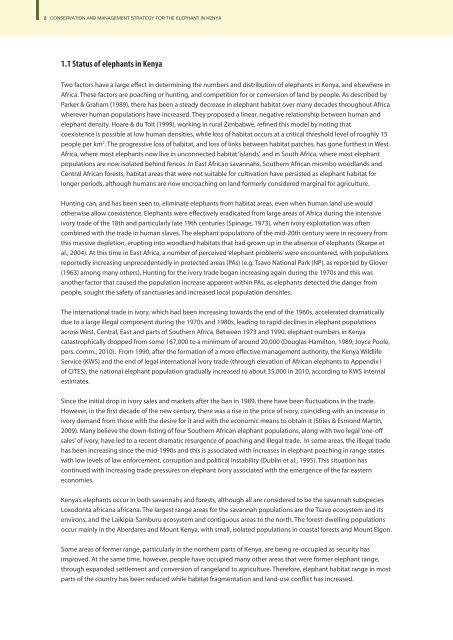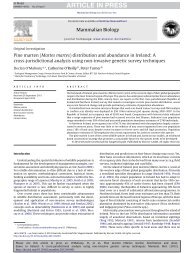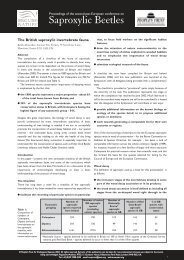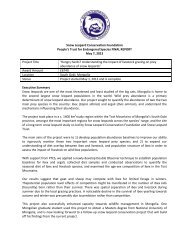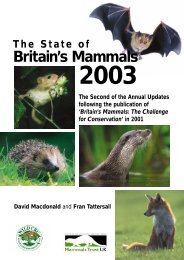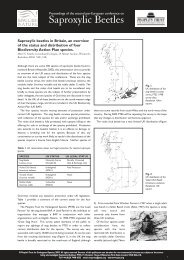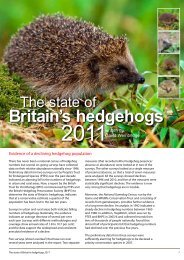National Elephant Strategy - People's Trust for Endangered Species
National Elephant Strategy - People's Trust for Endangered Species
National Elephant Strategy - People's Trust for Endangered Species
You also want an ePaper? Increase the reach of your titles
YUMPU automatically turns print PDFs into web optimized ePapers that Google loves.
2 CONSERVATION AND MANAGEMENT STRATEGY FOR THE ELEPHANT IN KENYACONSERVATION AND MANAGEMENT STRATEGY FOR THE ELEPHANT IN KENYA 31.1 Status of elephants in KenyaTwo factors have a large effect in determining the numbers and distribution of elephants in Kenya, and elsewhere inAfrica. These factors are poaching or hunting, and competition <strong>for</strong> or conversion of land by people. As described byParker & Graham (1989), there has been a steady decrease in elephant habitat over many decades throughout Africawherever human populations have increased. They proposed a linear, negative relationship between human andelephant density. Hoare & du Toit (1999), working in rural Zimbabwe, refined this model by noting thatcoexistence is possible at low human densities, while loss of habitat occurs at a critical threshold level of roughly 15people per km 2 . The progressive loss of habitat, and loss of links between habitat patches, has gone furthest in WestAfrica, where most elephants now live in unconnected habitat ‘islands’, and in South Africa, where most elephantpopulations are now isolated behind fences. In East African savannahs, Southern African miombo woodlands andCentral African <strong>for</strong>ests, habitat areas that were not suitable <strong>for</strong> cultivation have persisted as elephant habitat <strong>for</strong>longer periods, although humans are now encroaching on land <strong>for</strong>merly considered marginal <strong>for</strong> agriculture.Hunting can, and has been seen to, eliminate elephants from habitat areas, even when human land use wouldotherwise allow coexistence. <strong>Elephant</strong>s were effectively eradicated from large areas of Africa during the intensiveivory trade of the 18th and particularly late 19th centuries (Spinage, 1973), when ivory exploitation was oftencombined with the trade in human slaves. The elephant populations of the mid-20th century were in recovery fromthis massive depletion, erupting into woodland habitats that had grown up in the absence of elephants (Skarpe etal., 2004). At this time in East Africa, a number of perceived ‘elephant problems’ were encountered, with populationsreportedly increasing unprecedentedly in protected areas (PAs) (e.g. Tsavo <strong>National</strong> Park (NP), as reported by Glover(1963) among many others). Hunting <strong>for</strong> the ivory trade began increasing again during the 1970s and this wasanother factor that caused the population increase apparent within PAs, as elephants detected the danger frompeople, sought the safety of sanctuaries and increased local population densities.The international trade in ivory, which had been increasing towards the end of the 1960s, accelerated dramaticallydue to a large illegal component during the 1970s and 1980s, leading to rapid declines in elephant populationsacross West, Central, East and parts of Southern Africa. Between 1973 and 1990, elephant numbers in Kenyacatastrophically dropped from some 167,000 to a minimum of around 20,000 (Douglas-Hamilton, 1989; Joyce Poole,pers. comm., 2010). From 1990, after the <strong>for</strong>mation of a more effective management authority, the Kenya WildlifeService (KWS) and the end of legal international ivory trade (through elevation of African elephants to Appendix Iof CITES), the national elephant population gradually increased to about 35,000 in 2010, according to KWS internalestimates.Since the initial drop in ivory sales and markets after the ban in 1989, there have been fluctuations in the trade.However, in the first decade of the new century, there was a rise in the price of ivory, coinciding with an increase inivory demand from those with the desire <strong>for</strong> it and with the economic means to obtain it (Stiles & Esmond Martin,2009). Many believe the down-listing of four Southern African elephant populations, along with two legal ‘one-offsales’ of ivory, have led to a recent dramatic resurgence of poaching and illegal trade. In some areas, the illegal tradehas been increasing since the mid-1990s and this is associated with increases in elephant poaching in range stateswith low levels of law en<strong>for</strong>cement, corruption and political instability (Dublin et al., 1995). This situation hascontinued with increasing trade pressures on elephant ivory associated with the emergence of the far easterneconomies.1.1.1 <strong>Elephant</strong> numbers, mortality and threatsEstimates of elephant numbers are used to compare population status in different parts of elephant range withincountries, regions and across the continent. Estimates are also used to evaluate trends of population growth ordecline. A variety of methods, from aerial total counts to rough guesses, have been used to obtain populationestimates, producing results with varying degrees of accuracy and precision. It should be noted that comparisonsbetween sites and through time are truly valid only when using data that have been collected using the samemethodologies. Producing regional or national totals by adding up estimates of different quality could be justified togive a general total, but should not be relied upon <strong>for</strong> accurate descriptions of elephant status.Estimating numbers and distribution of elephant populations in savannah habitat is relatively straight<strong>for</strong>ward, sincevisibility in the open vegetation allows direct counting using standard techniques common across Africa, such asaerial total or sample counts and ground counts or individual recognition studies. <strong>Elephant</strong> populations in thickbushland or <strong>for</strong>est, by contrast, must be estimated by indirect methods, primarily involving dung surveys. Thesemethods when properly designed and undertaken can produce figures that are as precise as direct counts (Barnes,2001; Hedges & Lawson, 2006). In some cases, the only available estimate <strong>for</strong> a remote population is an ‘in<strong>for</strong>medguess’. As noted above, it would be misleading to estimate a single set of figures <strong>for</strong> the size or trend of Kenya’snational elephant meta-population by simple addition of estimates of all the individual populations. Trend data,based on repeated estimates using the same methodology, are available <strong>for</strong> some key populations and can be usedto contribute to an overall picture of the current position and future prospects of elephants in the country.There are three sources of in<strong>for</strong>mation on elephant status in Kenya:1. Reports prepared by KWS (Kenya Wildlife Service) staff and consultants.2. KWS Policy Framework and Development Programme 1991-1996, otherwise called KWS ‘Zebra Books’:Annex 7 The Conservation of <strong>Elephant</strong>s and Rhinos.3. The African <strong>Elephant</strong> Status Reports (<strong>for</strong>merly the African <strong>Elephant</strong> Database) which provided national-levelsummaries on a more-or-less regular basis since 1995 by the African <strong>Elephant</strong> Specialist Group (AfESG) of the <strong>Species</strong>Survival Commission (SSC) of the International Union <strong>for</strong> Conservation of Nature (IUCN), using in<strong>for</strong>mation suppliedby KWS.All three sources were used to present a description of elephant status, with the AfESG reports providing a broadoverview and historical summary and the most recent report (Thouless et al., 2008) providing a more detailedanalysis.The AfESG reports dating from 1995 to 2007 provide a summary of comparable data on numbers with a clear outlineof the type and quality of data, and a thorough discussion of methodological issues surrounding the reliability ofsurvey data. The results <strong>for</strong> Kenya from the AfESG reports from 1995 (Said et al., 1995), 1998 (Barnes et al., 1999), 2002(Blanc et al., 2002) and 2006 (Blanc et al., 2007) are provided in Table 1. The results were provided <strong>for</strong> different surveyareas in the different reports; they have been re-grouped into KWS Conservation Areas (regions) <strong>for</strong> the purposes ofthis national strategy. An up-to-date summary of elephant numbers based on KWS data is provided in Table 2.Kenya’s elephants occur in both savannahs and <strong>for</strong>ests, although all are considered to be the savannah subspeciesLoxodonta africana africana. The largest range areas <strong>for</strong> the savannah populations are the Tsavo ecosystem and itsenvirons, and the Laikipia-Samburu ecosystem and contiguous areas to the north. The <strong>for</strong>est-dwelling populationsoccur mainly in the Aberdares and Mount Kenya, with small, isolated populations in coastal <strong>for</strong>ests and Mount Elgon.Some areas of <strong>for</strong>mer range, particularly in the northern parts of Kenya, are being re-occupied as security hasimproved. At the same time, however, people have occupied many other areas that were <strong>for</strong>mer elephant range,through expanded settlement and conversion of rangeland to agriculture. There<strong>for</strong>e, elephant habitat range in mostparts of the country has been reduced while habitat fragmentation and land-use conflict has increased.


